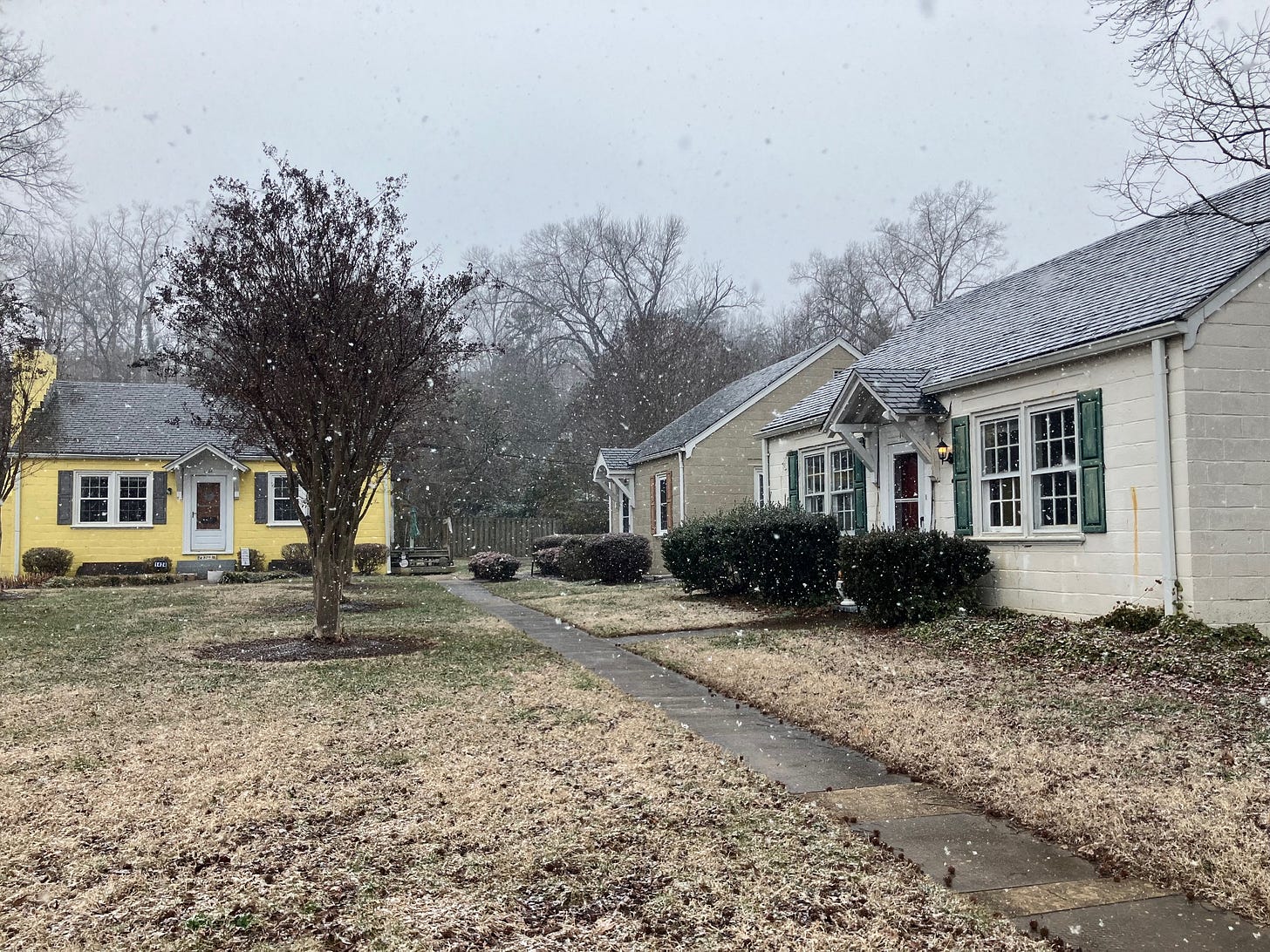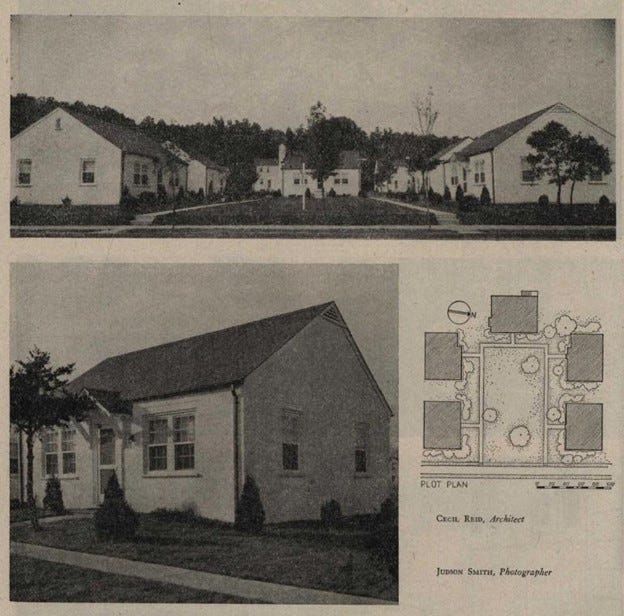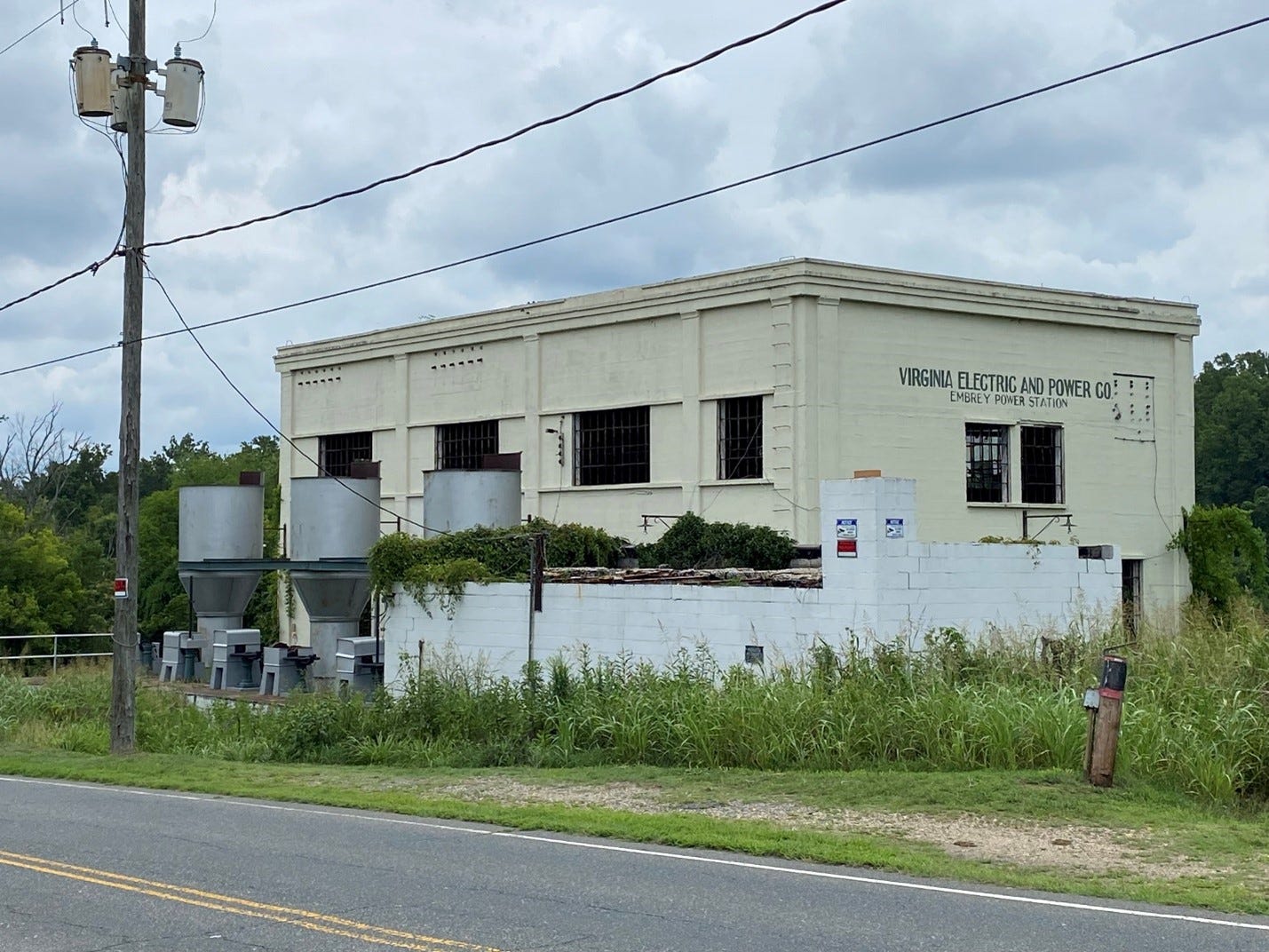History Thursday: Cecil Reid's Cottage Courts
Reid's Court and Caroline Terrace on Franklin Street in the College Terrace neighborhood are examples of historic designs that could solve today's affordability problems.
By Adele Uphaus
MANAGING EDITOR AND CORRESPONDENT
Email Adele

In 1946, the Book of Houses described the five small pastel-colored concrete block houses at 1420-1428 Franklin Street in Fredericksburg as individually “undistinguished.”
But all together, the book’s authors found the miniature development of five homes grouped around a shared green space—known as “Reid’s Court” after architect Cecil Reid—to be delightful:
…by combining them in a pleasing neighborhood plan, the group takes on a character which the individual house does not possess. And a neighborhood of this sort has many advantages in livability which go far beyond the mere pleasant appearance of the structures. With land as plentiful as it is in the United State and with the raw land comprising such a small part of the total cost of a completed house, we may ask ourselves why all our neighborhood developments are not so intelligently planned and constructed as the one shown above.
Reid’s Court was constructed in 1938. It was an original concept in Fredericksburg, but it reflected the early 20th-century “Garden City” movement in urban planning, according to research conducted by Michael Spencer, professor in the University of Mary Washington’s department of historic preservation, for the Historic Fredericksburg Foundation.
“The movement emphasized affordability as well as interaction with green spaces,” Spencer wrote in a blog post about Cecil Reid. “Both developments [Reid’s Court and Caroline Terrace, which is located next door at 1430 Franklin Street and named after Reid’s wife], while vastly different in scale, created neighborhood courtyards that provided residents with community green space free of automobiles, which were relegated to the street or rear of the development.”

Reid’s Court and Caroline Terrace are both approaching 100 years old but are examples of developments that could solve housing shortage and affordability problems that plague Fredericksburg today, experts told the Advance in January.
“If you can take a single lot and group eight cottages on it,” said Robert Steuteville, who is director of publications at the Congress for the New Urbanism in Washington, D.C., “it’s not only nice socially and a nice environment, but it also reduces the land cost for each unit. Then you can factor that in to get a smaller house with a smaller number.”
Cecil Reid was a forward-thinking residential architect, but he only started designing homes late in his career. His earlier work, which brought him to Fredericksburg from South Carolina in 1906, was designing hydroelectric power plants. He designed the Embrey Power Station, which was completed in 1911, as well as numerous other plants across Virginia.
Reid was also responsible for creating the Department of Manual Training at Fredericksburg High School (now James Monroe High School), according to Spencer, and he served on City Council from 1933–1942.
According to a 1938 profile in the Free Lance-Star, Reid was a “peculiar type of public official” who “has never asked a person to vote for him.”
“When he was a candidate for reelection four years ago, as he is today, he made no canvas, no solicitation, and on the day of election, he was away on a trip,” the article states. “He received the highest number of votes ever attained in a contested Council election.”
Reid was only willing to serve, according to the article, because the citizens wanted him.
“But I believe that every citizen should put public duty above self for it is through this we can better our community and make the world a bit better for our having existed in it,” he told the Free Lance-Star.

Reid began to design and build homes in the College Terrace neighborhood while he was serving on City Council, according to Spencer. He had bought and sold real estate before, but design was new to him.
In addition to Reid’s Court and Caroline Terrace, he designed and built homes on Grove Avenue, Sunken Road, and Canal Street.
Cost was always an important factor for Reid, according to Spencer, which is why he designed with concrete block instead of brick. The entire Reid’s Court project had a permitting cost of $7,000, according to Spencer—about $155,732 in today’s dollars—and the Reid house at 312 Canal Street was even more cost-effective at $1,200.
The “economical designs [Reid] used … when coupled with the introduction of quality materials [such as slate roofs and concrete blocks] and green space, serve as one of Fredericksburg’s few noteworthy references to the interwar (1918–1939) Garden City planning movement,” Spencer wrote, and still help define the College Terrace neighborhood.
Cottage courts like Reid’s Court and Caroline Terrace are gaining attention as examples of “missing middle” housing, along with duplexes, fourplexes, and live-work buildings, that used to be more common in neighborhoods before World War II.
The City of Waynesboro last month approved an amendment to its zoning ordinance that would allow for cottage court housing, which it describes as “a group of small, detached houses, attached houses, townhouses (limit of 4 attached units per structure and up to 50% of development), or tiny homes fronting around a common space.”
Local Obituaries
To view local obituaries or to send a note to family and loved ones, please visit the link that follows.
Support Award-winning, Locally Focused Journalism
The FXBG Advance cuts through the talking points to deliver both incisive and informative news about the issues, people, and organizations that daily affect your life. And we do it in a multi-partisan format that has no equal in this region. Over the past year, our reporting was:
First to break the story of Stafford Board of Supervisors dismissing a citizen library board member for “misconduct,” without informing the citizen or explaining what the person allegedly did wrong.
First to explain falling water levels in the Rappahannock Canal.
First to detail controversial traffic numbers submitted by Stafford staff on the Buc-ee’s project
Our media group also offers the most-extensive election coverage in the region and regular columnists like:
And our newsroom is led by the most-experienced and most-awarded journalists in the region — Adele Uphaus (Managing Editor and multiple VPA award-winner) and Martin Davis (Editor-in-Chief, 2022 Opinion Writer of the Year in Virginia and more than 25 years reporting from around the country and the world).
For just $8 a month, you can help support top-flight journalism that puts people over policies.
Your contributions 100% support our journalists.
Help us as we continue to grow!
This article is published under Creative Commons license CC BY-NC-ND. It can be distributed for noncommercial purposes and must include the following: “Published with permission by FXBG Advance.”















This is really interesting. I walk my dog on Franklin all the time and have always wondered what the story was behind those houses, so thank you! Do you happen to know which house(s) on Sunken Road he designed?
These articles on town architecture are most interesting and informative. Thanks.